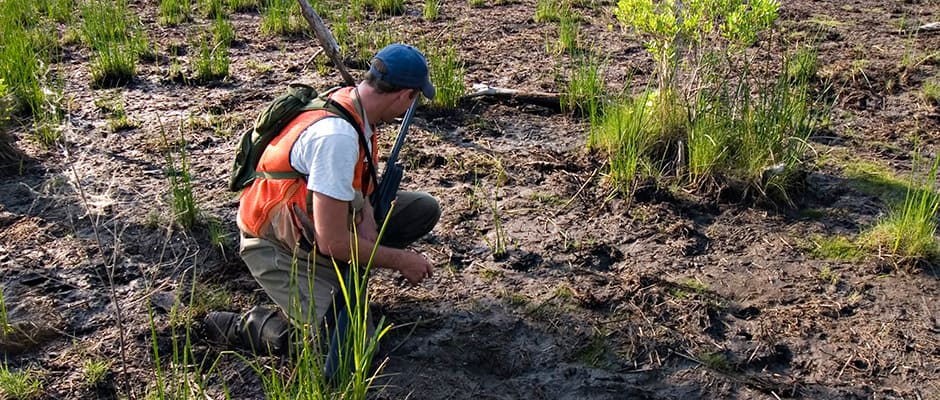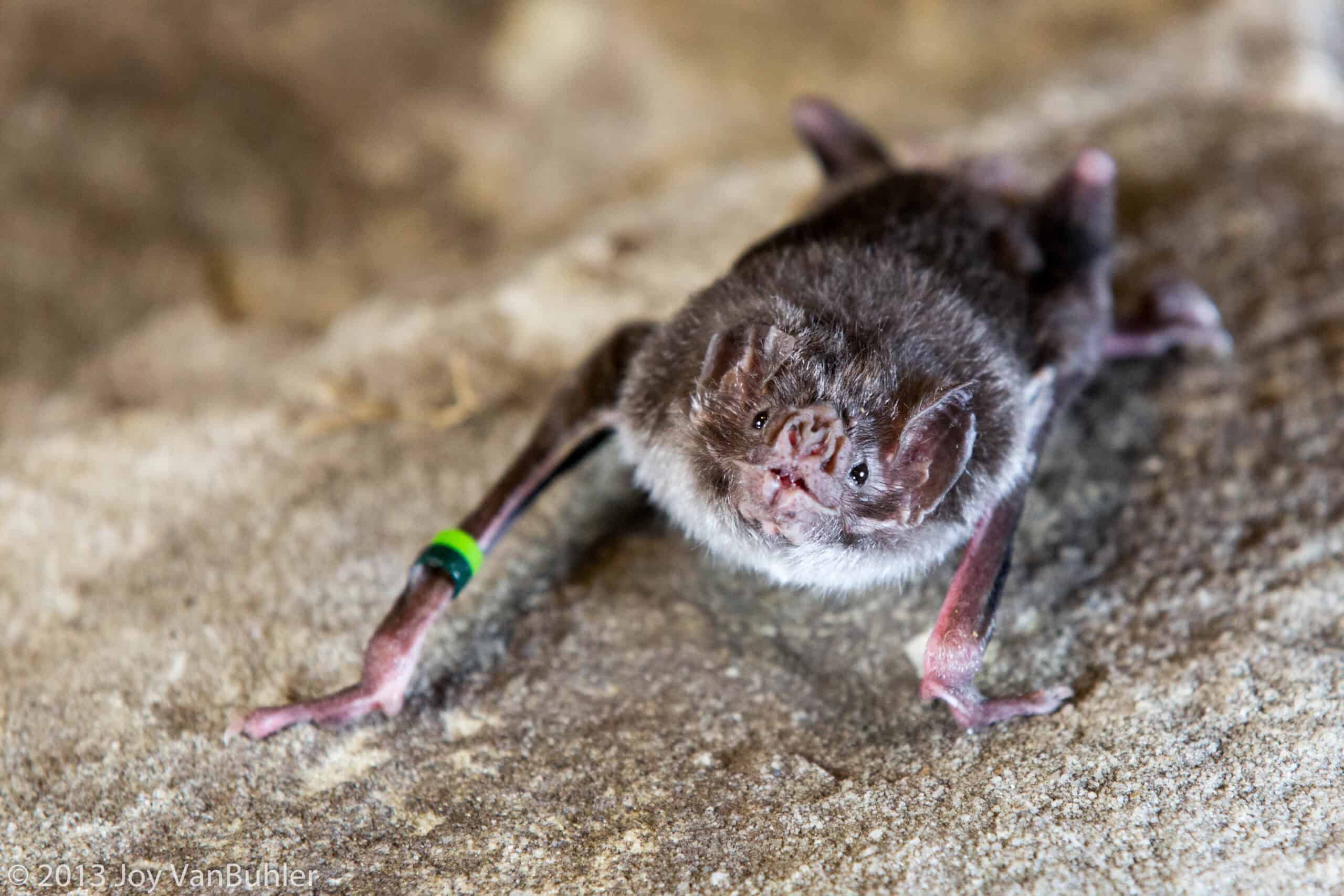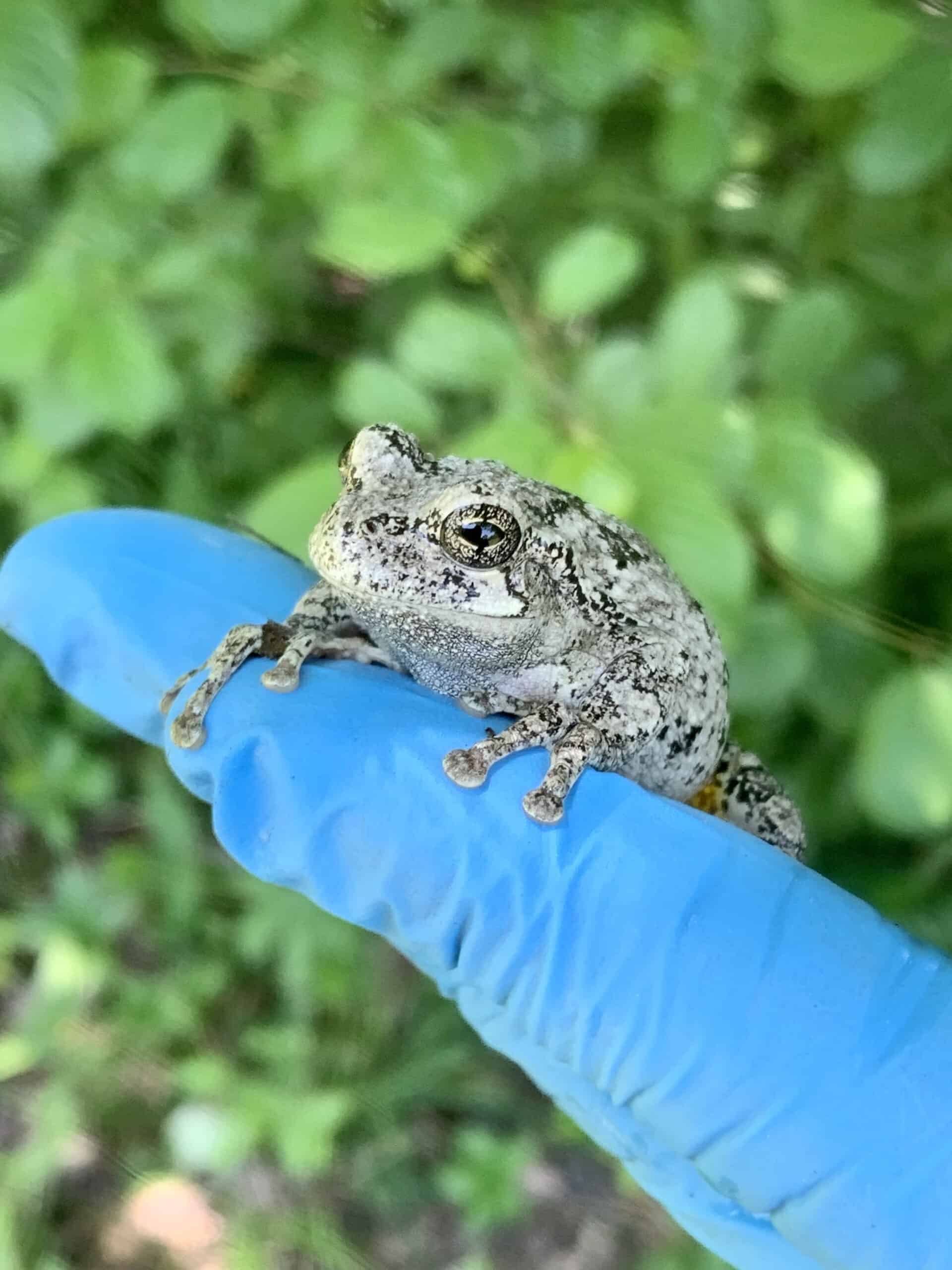Share this article
Restoration Through Eradication
From the spring issue of The Wildlife Professional.
The Chesapeake Bay Nutria Eradication Project
Throughout the 1900s, nutria (Myocastor coypus) — South American semi-aquatic rodents once prized for their pelt — were commercially propagated at fur farms around the world. Many such commercial ventures failed, and the animals escaped or were released into environments surrounding the fur farms. Such was the case near Blackwater National Wildlife Refuge on Maryland’s Eastern Shore where nutria were first released in 1943.
Known to be prolific breeders, nutria give birth to large litters of five to seven young as often as three times per year. Once free, populations can grow quickly and spread across the landscape. In Blackwater, the digging, rooting, and burrowing behavior of these rodents as they consumed wetland vegetation led to extensive erosion of coastal wetlands and damage to agricultural crops, water control structures and roads. In fact, nutria contributed to converting more than 5,000 acres of emergent marsh to open water at this refuge alone. Tens of thousands of acres of surrounding state and privately owned wetlands also were impacted.
Stemming the Damage
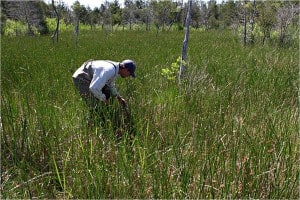
A Wildlife Services field specialist inspects the same marsh as above in the Delmarva Peninsula, which began showing signs of recovery two years after the removal of a nutria population.
Image Credit: Stephen Kendrot
In order to protect the area from further damage, numerous entities — including a major landowner — joined forces in the mid-1990s to discuss a nutria eradication plan covering the Delmarva Peninsula. The group formed a Nutria Management Team — consisting of representatives from the U.S. Fish and Wildlife Service, the Wildlife Services of the U.S. Department of Agriculture’s Animal and Planet Health Inspection Service, Maryland Department of Natural Resources, U.S. Geological Survey, Cooperative Fish and Wildlife Research Unit, the University of Maryland Eastern Shore, and the privately held Tudor Farms —to lead the effort.
After several years of research and planning, the group asked WS to spearhead the Chesapeake Bay Nutria Eradication Project (CBNEP) funded by FWS. As project leader for WS, I assembled a team of 15 wildlife specialists to take on this monumental task, which covered nearly 800 square miles. Half the crew was drawn from the local community — hunters, trappers, and watermen who were intimately familiar with the maze of backwaters in the Chesapeake Bay and whose knowledge of the area was critical for training the remaining crew — a rotating cast of newly minted wildlife professionals from across the country.
Rolling Out the Plan
Driven by a passion for protecting the beleaguered Chesapeake marshes, armed with a science-based trapping protocol, and equipped with the boats, boots, GPS units, traps, and firearms to get the job done, the team launched its mission in June 2002.
We divided the marsh into 40-acre plots — the estimated size of nutria home ranges — and tested two trapping strategies: saturation versus perimeter. In saturation trapping, specialists scoured the entire plot, setting traps wherever nutria signs were present. In perimeter trapping, traps were set within a narrow band along the plot’s perimeter to determine if all the nutria within the plot could be caught by trapping over a smaller area.
The team quickly discovered that rapid removal of all nutria would require going where the nutria go. With each specialist working a row of plots, the team spread column-by-column across the expansive brackish marshes that typify Blackwater NWR, in a pattern that we dubbed “Rolling Thunder.”
This name characterized our mission, which was to completely eradicate a mainland population using trapping as the primary removal method and a first-of- its-kind in North America.
Since we were breaking new ground, adaptive management became our motto. Quite early, it was clear that complete removal of the animals in a single pass was not likely, so we developed a monitoring protocol to ensure previously trapped areas were periodically inspected for remnant populations. The four individuals dedicated to this effort, however, quickly became overwhelmed and demoralized by the ever-expanding area they monitored. The trappers were catching dozens of nutria daily, but the monitoring team walked countless miles with few discoveries for their effort — a bitter pill for dedicated trappers who measure success in numbers.
To keep the team energized, we redesigned the monitoring protocol to involve all staff in alternating between trapping and monitoring. The new protocol included one team member’s idea of using dogs to track nutria and reduce the trapping effort. Six members eventually trained their personal dogs to track down and hold nutria at bay. Although the dogs didn’t account for large numbers of nutria being removed, they dramatically reduced the time required to capture the last few.
Expanding the Removal Area
Within two years, the eradication team had nearly eliminated nutria from Blackwater NWR, and by 2006, they had expanded the nutria eradication zone to include all of southern Dorchester County in Maryland. The effect of their work was immediately observable. As nutria were removed, the specialists noticed that the rhizomes of wetland plants began reclaiming the swim channels dug by the animals as well as trapping sediments and slowing down erosion. Riddled with holes and littered with nutria track when the trapping program began, sparsely vegetated mudflats were flush with new growth within a single growing season. Researchers from nearby Patuxent Wildlife Research Center, who had been studying nutria impacts at Blackwater NWR for decades, also confirmed these observations empirically.
Moving to the Choptank River
Bolstered by the success at and surrounding Blackwater NWR, in 2008 the crew turned its attention to the Choptank River, which begins more than 40 miles upstream of Cambridge, Md., and empties into the Chesapeake Bay. Lined with thousands of acres of freshwater tidal marshes, the Choptank presented entirely new challenges such as differences in nutria habitat and distribution as well as behavior and movement patterns. Tidal fluctuations also required adjustments to search image and trapping techniques.
In addition, with all the land along the Choptank under private ownership, the team had to obtain access agreements from hundreds of owners. Amazingly, not a single landowner denied access — a testament to their awareness of the nutria threat and the trust the team had established in the community through their work on public and private lands surrounding Blackwater NWR.
It took several years to clean out the Choptank — including periodic departures to monitor previously trapped areas — but by May 2011, trapping returns had dwindled to nothing. Imagine our surprise when an FWS colleague returned from a visit to a local fur buyer with a report that an Amish youth had trapped a nutria in a small mill pond that forms the headwater of the Choptank River. Our investigation revealed a small, isolated population on the pond, which straddles the Maryland-Delaware border nearly 20 miles upstream of the nearest capture on the river’s main stem. The team removed only six nutria, and none have returned since.
The Final Push
The team was now well versed in the extensive habitats occupied by nutria in the Delmarva Peninsula; however, it was becoming clear that the tools and techniques used to depopulate nutria wouldn’t necessarily serve us well in the final stages of the campaign when simply finding nutria was far more difficult than trapping them.
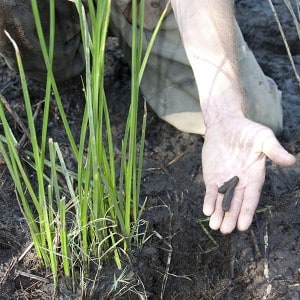
Nutria tracks and droppings cover the ground in this heavily damaged marsh located on the Chesapeake Bay in Maryland.
Image Credit: Stephen Kendrot
In the fall of 2009, staff requested an external review to get an outside perspective on the accomplishments and obstacles to success. A three-member team from Invasive Species International — a technical advisory group from Landcare Research in New Zealand — reviewed the program and wrote a 56-page report with nearly two dozen recommendations.
First among those recommendations was conducting a delimiting survey to determine the distribution of remaining nutria populations on the Delmarva. The CBNEP crew logged thousands of miles over the next two years — searching wetlands and waterways in Delaware, Maryland, and Virginia. Ultimately, the team determined that the remaining nutria populations were confined to four watersheds on Maryland’s lower Eastern Shore: the Wicomico, Manokin, Annamessex, and Pocomoke Rivers.
Knowledge gained from the delimiting survey guided a new strategy for this effort. The team worked watershed-by-watershed to eliminate outlying populations that had sprung up from the original infestation in the 1940s. In 2014, the last known established nutria population was removed from the Delmarva. Over the 12-year project, the team had scoured a quarter-million acres of emergent marsh spread across three states and removed nearly 14,000 nutria in the process.
Victory?
Of course, it’s not the number of animals removed but the number left behind that determines successful eradication. Critical to the team’s ultimate success was developing effective methods to ensure that no nutria escaped detection. With a grant from the National Fish and Wildlife Foundation, we explored the use of radio-tagged “Judas” nutria to discover remnant populations. The technique was effective in finding nutria, but was labor intensive and cost prohibitive at the landscape level. A floating raft outfitted with a hair snare turned out to be a more cost effective as well as efficient detection method that could be deployed easily at a landscape scale.
Observer-based sign searches also are invaluable in the right conditions, but their reliability is subject to environmental fluctuations. In order to strengthen these surveys, the team once again turned to dogs. In contrast with the employee-owned dogs that had been helpful hunting nutria, these new agency owned detector dogs were trained to detect nutria spoor and play a critical role today in declaring areas nutria-free.
Bring Back the Dogs
Nutria-hunting dogs need to find a few nutria to keep them on top of their game; however, this is a rare occurrence at the end of an eradication campaign. Fortunately, the dogs’ skills can be kept current and validated using planted training aids such as scat. Working with the USDA’s National Detector Dog Training Center (NDDTC), two team members went through an intensive 12-week training course to learn how to train and handle conservation detection dogs.
Beginning with procurement training, the team learned what to look for in candidate dogs — high energy, obsession with toys, bark response, and good temperament. The duo visited dozens of animal shelters, websites, and breeders and evaluated hundreds of dogs before settling on four Labrador retrievers and lab mixes meeting the criteria. Following a five-week obedience and scent association training exercise at NDDTC in Georgia, the dogs and handlers returned to Maryland to continue training in realworld field environments. After another five weeks of training, the handler/canine teams graduated at Blackwater NWR in November, 2014.
The next step for these newly minted nutria detector dogs will be refining and incorporating their skills into survey methodologies. Long term, the handlers will become trainers themselves and train four more teams. In our experience, the dogs’ keen sense of smell vastly enhances the handlers’ ability to detect sign beyond their field of view.
Conservation Partnerships
The CBNEP story demonstrates what can be accomplished through partnerships in conservation. Over the next two to four years, the team will scour every inch of the depopulated marsh several times in an effort to verify successful eradication following the 12-year program. To date, a few isolated nutria have been detected and removed; however, the team remains confident that with continued agency support, the environmental threat posed by nutria on the Delmarva Peninsula can be forever eliminated and the marshlands will be restored to their natural state.
Author Bio

Image Credit: USDA APHIS
Stephen Kendrot, MS, CWB, a Wildlife Society member since 1993, is the deputy director for Wildlife Operations at the United States Department of Agriculture Animal and Plant Health Inspection Service headquarters in Riverdale, Md.
Wildlife Services Profile
A Strategic Partner of The Wildlife Society
Wildlife Services (WS), a program within USDA’s Animal and Plant Health Inspection Service agency, provides federal leadership and expertise to resolve conflicts and create a balance that allows people and wildlife to coexist. The agency provides its services in response to local requests to combat identified damage and depends on the financial support of those requesting assistance. Projects are often conducted as partnerships with public-private alliances as well as cooperating federal, state, and local agencies.
Today, WS staff employs traditional naturalists’ skills, enhanced by modern technologies and guided by a scientific process. As wildlife damage evolves and occurs more frequently, the need for these knowledge and skills at airports, emergencies such as disease outbreaks and oil spills, and other challenging conflicts in both the public and private sector is growing steadily. WS’ 1,600 trained professionals respond to requests for operations, disease surveillance and response, and research related to wildlife damage.
Each WS state office is led by trained and experienced wildlife biologists, many of whom are members and certified by The Wildlife Society. TWS is pleased to welcome WS as a strategic partner, in recognition of its commitment to professionalism and responsible stewardship of public trust natural resources.
The Wildlife Professional is a TWS member benefit. Join TWS to take advantage of this and other member benefits.
Header Image:
A wildlife biologist inspects nutria damage to a three-square bulrush marsh in Somerset County, Md. Such damage was widespread as nutria spread unchecked in the Delmarva Peninsula for more than 75 years.
Image Credit: Stephen Kendrot



